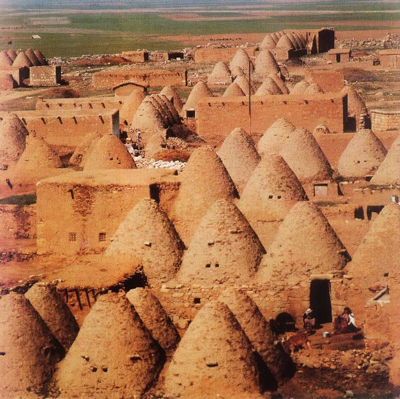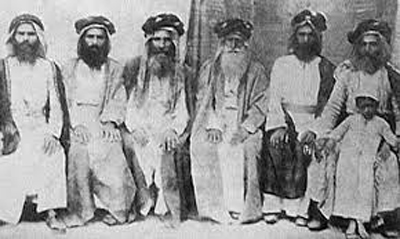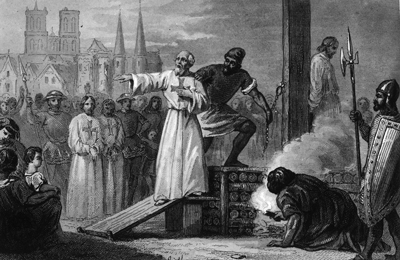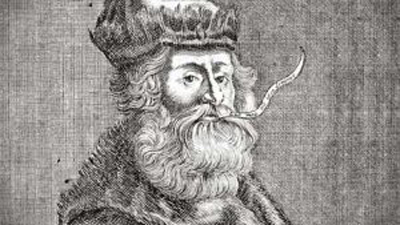Men in Black: The Hidden History of the Knights of Malta (2)
In all the annuals of conspiracy literature there is probably no other organization more misunderstood and misrepresented than the Sovereign Military Order of Malta (SMOM), more commonly known as the Knights of Malta. In this article we shall mainly focus on the aspects of the Order that no doubt most interest our readers: namely, its ties to espionage and the occult.
Read the first part of the article
But back to the Holy Land. The Nizari were but one of several strange sects, along with the likes of the closely related Druze, the Yazidis, and the Mandaens, engaged in highly esoteric practices that the Hospitallers and other Crusaders encountered in the Holy Lands. The Sufi movement was also in its infancy at this time and it’s possible that remnants of the Harran Sabians could still be found in Syria at the same time the Knights Hospitaller were rubbing shoulders with the Nizari.

Ruins of the legendary city of Harran
The Harran Sabians were a curious bunch. The Sabians were mentioned several times in the Quran as “peoples of the Book” and are now believed by many scholars to be derived from the Mandaens, Johnites whose belief system is closely related to Gnosticism. The Harran Sabians, by contrast, appear to have adopted the name Sabian to spare their pagan beliefs after the Islamic conquest. At the core of their belief system was a reverence for Hermes Trismegistus.
“Notable in this process of translation and research was the Sabian intellectual community of Baghdad, which thrived under an enlightened caliphate between the ninth and mid-tenth centuries AD. The Sabians had, in order to qualify for respect as ‘people of the Book’ as directed by the Koran, taken the philosophical writings of Hermes Trismegistus as their prophetic work, their holy book.
The philosophy of Hermes was congenial to Baghdad’s Muslim authorities because it represented the unity of God and the cosmos. Hermes was congenial to the so-called Sabians because they had originally come from Harran in northern Syria, where the lights of the cosmos were venerated; Harran had seven temples, each dedicated to a planet.” (The Invisible History of the Rosicrucians, Tobias Churton, pgs. 103-104)
We’ve digressed to discuss the Harran Sabians here because the Maltese knights appear to have developed quite an interest in alchemy several centuries later and it is generally felt that Western alchemy arose from Hermeticism. And the Harran Sabians were one of the key conduits to transfer Hermeticism from the ancient world to the Middle Ages. They were also reported to be early alchemists as well.

As such, there would have been no shortage of esoteric creeds ranging from Hermeticism, Gnosticism and Isma’ilism, among others, for the Crusading knights to absorb. As one of the wealthiest and most influential orders of the Crusader era, the Knights Hospitaller would have been especially well placed to study such creeds. But their potential involvement with these sects has been largely overshadowed by their far more famous rivals, the Knights Templar.
The Hospital and the Temple
The relationship between the Knights Templar and the Knights Hospitaller has long been shrouded in controversy. The Hospitallers predated the Templars and there appears to have been an early influence. But the Templars took up arms before the Hospitallers, which no doubt led to the transformation of the latter into a full blown military order. Many accounts insist, however, on an ever growing rivalry between the two orders that appeared headed towards open conflict in the years leading up to the suppression of the Templars.
“As part of the planning of a new Crusade, the pope had indicated that he wanted to discuss the proposal that the Templars and the Hospitallers be merged into one order, an idea that had been coming up more frequently in recent years. Just two years earlier a Dominican friar, Raymond Lull, had written a merger plan that had aroused much interest. He proposed that the Knights of the Hospital of St. John of Jerusalem and the Knights of the Temple of Solomon be combined into a single order to be called the Knights of Jerusalem, and that all of the rulers of Europe combine their Crusading forces under a single commander to be known as the Rex Bellator, the ‘War King.’ A few years earlier a French priest, Pierre de Bois, had submitted a written plan for the recuperation of the Holy Places called De Recuperatione Sanctae, in which he cited the efficiencies to be achieved by combining the military orders.
The pope had responded favorably to the merger concept. The Hospitalers had brought new hope for a crusade and new respect to themselves by the recent invasion of the island of Rhodes, and the pope leaned towards the appointment of Foulques de Villaret, Grand Master of the Hospitallers, as Grand Master of the proposed combination.” (Born in Blood, John J. Robinson, pg. 128)
This proposed merger was effectively carried out with the suppression of the Knights Templar in 1312, of which the Knights Hospitaller were one of the chief benefactors of.
“That order has managed to escape any criticism in the matter of the Templar suppression, but apparently only because it had kept a low profile throughout, probably for the very good reason that its role and its rewards at been worked out in advance. It is well known that the papacy was in favor of the union of the Templars and Hospitallers and had already determined that Foulques de Villaret, master of the Hospitallers, would be the Grand Master of the combined orders. The Templars, at their headquarters in Cyprus, had heard of the serious intent to combine the orders and had taken the time to prepare a written rebuttal. The Hospitallers, at their own headquarters on the same island, must have received the same information, yet they prepared no rebuttal, written or verbal. In fact, de Villaret managed to stay away from the meeting in France altogether, with no recorded papal criticism for his absence. That was undoubtedly because his presence wasn’t needed and because there was no point in chancing a confrontation between the two orders, especially since the pope was already dedicated to looking after the interests of the Hospitallers.
Not only did the Hospitallers offer no objection to the concept of the merger, but they made no attempt whatever to speak up for their brother warrior-monks as they were arrested and tortured. They simply stayed out of it and bided their time, until Clement V, much to the anger of King Philip, declared that all of the confiscated Templar property would go to the Knights Hospitallers and that all released Templars could be taken into the Hospitaller order, thereby achieving de facto the union he had been planning all along, with full Hospitaller approval and cooperation. If one looks for motive, the Hospitaller order was the major beneficiary of the suppression of the Templars, as it probably been plan from the beginning. The pope and the Hospitallers together thwarted the aims of Philip of France, and there should be no doubt that the Hospitallers rank as one of the three assassins of the Order of the Temple.” (Born in Blood, John J. Robinson, pgs. 272-273)
There’s a lot to taken in here. A good starting point may be the little-remarked upon role the above-mentioned Ramon Llull played in the suppression of the Templars. A Spanish Franciscan monk, was one of the earliest and most vigorous supporters of merging the Templars and the Hospitallers. Llull had ventured to the island of Cyprus in 1299 to convert the infidel and appears to have been poisoned in 1302. He was ultimately saved by Jacques de Molay, the last Grand Master of the Knights Templar who famously burned at the stake.

Jacques de Molay
Afterwards Llull reportedly pitched de Molay his merger plan, which the Grand Master was not favorably disposed towards. Despite de Molay having saved his life, Llull continued to promote his merger plan and went on to argue for the confiscation of Templar property by the Knights Hospitaller in the wake of the suppression of the former order.
In addition to being a Franciscan with some sway in the Catholic hierarchy, Llull was also a mystic and early alchemist. One would expect him to be very interested in the ideas the Templars and the Hospitallers were being exposed to in the Holy Lands and to be sympathetic in general to the plight of the Templars. Not only had his life been saved by de Molay, but he was a fellow heretic operating within the frame work of the Catholic Church. And yet he backed the Hospitallers.

Ramon Llull
Was there something about the Knights of the Hospital that intrigued Llull beyond their ability to continue the Crusades? Unfortunately, this is a question little explored. But moving along.
The above reference Robinson makes to the “three assassins of the Order of Temple” is a reference to Masonic myths surrounding the Biblical figure of Hiram Abiff, whom the Masons claim as their founder. In Masonic lore Hiram is murdered by three unworthy craftsmen (sometimes referred to as “Ruffians”) while working on the Temple of Solomon. Robinson speculated that these “Ruffians” (referred to as Jubela, Jubelo and Jubelum) were stand-ins for the suppression of the Templar order, with the three unworthy craftsmen representing King Philip of France, Pope Clement V and the Knights Hospitaller.
This is in stark contrast to much conspiracy literature, which tends to depict the Knights of Malta as lackeys of the Freemasons. There is little evidence of this, however. The Scottish Rite degree named after the Knights of Malta appears to reflect Robinson’s take on the Maltese knights as assassins (while still showing a certain admiration for the Order). And famed nineteenth century Freemason Albert Mackey, in his encyclopedia of Masonry, proclaimed the Maltese knights to be longstanding foes of the Masons:
“As regards Freemasonry it may be said in general that the Knights were antipathetic to it, or to any such teachings or truths as Masons held at any period. In particular, the Order was twice used in attempts to destroy Freemasonry, and it therefore has at one time or another belong to that long chapter of the history of the Fraternity which is called Anti Masonry.
It has been an open and confessed military arm of the Vatican before the Pope issued their first Bull against Freemasonry in 1738, and it was ordered to oppose Freemasonry wherever it could. In about 1800 it was instrumental in driving Freemasonry out of Russia. When Metternich after 1815 and the Congress of Vienna became the dictator of Europe he made the complete climination of the Fraternity one of his open and principal aims; and to a large extent he succeeded for some years, and may be described as the most powerful Anti-Mason of the nineteenth century.
The Knights of Malta were one of the agencies employed by him…” (Encyclopedia of Freemasonry, Vol. 3, Albert Mackey, pg. 56)
In recent years the linkage between the Knights of Malta and Freemasonry has been revived by no less than Pope Francis himself, who has demanded that the Maltese knights purge Freemasons from their ranks.
The presence of Freemasons among the Maltese knights is certain, however. In modern times this connection was laid bare in the scandal surrounding Propaganda Due (P2), the infamous Italian Masonic lodge linked to Operation Gladio and a host of terror attacks in Italy and beyond. As was noted before here, the upper echelon of P2 was almost totally dominated by the Maltese knights and the closely related Opus Dei. In other words, reactionary Catholic orders were using Masonic lodges (as there were other Propaganda lodges across Europe) as cover for a host of illegal and immoral activities. Some have suggested that this use of “unclean hands” was to further distance the Maltese knights from the deeds they were engaged in.
This is compelling, but there could be yet another motive: to give yet another black eye to a longstanding foe of the Order. P2 has provided much fodder to conspiracy researchers obsessed with Masons who in turn almost totally ignore the dominating influence the Maltese knights had over P2. In many ways, it would be difficult for a reactionary Catholic order to come up with a more perfect cover.
And with that we shall wrap things up for now with the following thoughts: the Knights of Malta emerged during the Crusades and spent nearly two centuries roaming the Holy Lands. There they likely encountered a host of esoteric ideologies from the likes of the Nizari, Mandeans, Yazidis, Druze and possibly even the Sabians and Sufis. It has been long suspected that their fellow Crusading military order the Knights Templar adopted some type of esoteric doctrine derived from some combination of these groups.
The Templar are then suppressed and persecuted in Europe, with the Knights Hospitaller ending up with their properties, members and possibly whatever occultic doctrines the Templars subscribed too. Certainly this more than echoes modern encounters of Men in Black who perform a similar function in regards to UFO revelations.
For the Knights of Malta, this was only the beginning. In the years to come they would encounter even more strange doctrines that they potentially embraced internally while suppressing among the general public. On the whole this is in rather stark contrast to speculative theories of the Knights Templar. If the Templars did in fact inspire Freemasonry, they ultimately made a host of esoteric doctrines accessible to the public at large through their lodges. The Knights of Malta, by contrast, preferred to keep this knowledge hidden.
yogaesoteric
April 14, 2019
